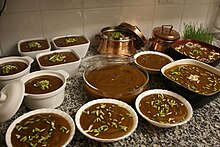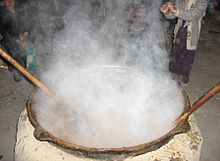Samanak
Samano (actually Saman-e nou , "new grass", from Persian سمنو, DMG samanū , 'grass') or Samanak ( Persian سمنک; ak = diminutive in Dari and Persian) is used in Afghanistan , Iran and other Central Asian countries as a decorative object for Nouruz , the New Year festival. Samanak is also used in Afghanistan and Tajikistan to denote a New Year's dish.
About two weeks before the Nouruz festival, i.e. H. On the 15th of the month of the zodiac sign Pisces, at the annual Khana Takani ceremony (“cleaning the house and clearing the oven”), seven types of grain ( wheat , rye , barley , spelled , oats , millet and green spelled ) are put in bowls for germination. The grain that grew best is then sown by the farmers.
The bowl with the seedlings , which until now served as decoration of the house, is separated from the green part on New Year's Eve according to the Iranian calendar or calendar according to the solar year or solar calendar (on the 19th in the leap year , otherwise on March 20th), pounded seven times in mortars and boiled 40 times.
These numbers symbolize the seven virtues (1) and the division of the year into a 40-day period ( chela ). The difference between the Iranian solar year and the Islamic lunar year or lunar calendar is about 10 and 11 days. If a person remembers two Ramazan months (month of fasting), which are in the same month of the solar year, then he is 40 years old. Furthermore, 40 days after the birth, wedding and death anniversary, the respective event is celebrated again. In addition, Tschla e Chord e Semestan wa ya Tabestan ("small 40 days" of winter or summer ) and Tschla e Bozorg e Semstan or Tabestan ("big 40 days" of winter or summer) are spoken in this culture and language area . This means the weeks of the lowest or highest temperature, the times of the first frosts or the onset of winter cold or the times of the lowest and highest summer heat. Spring ("Bahar") and autumn ("Paies" or "Khazan") are not affected.
The mixture (juice and germs) is kept in a saucepan overnight at a low temperature as long as young women. stirred until it becomes a pulp. This is important so that the enzymes can break down the starch into sugar. They sing the Nauro song or other songs all night long and play the tambourine .
The song is very long, here is the translation of some verses:
- Samanak is in the pot and we're stirring it
- The children are sleeping, we should be quiet
- Samanak is a dish to honor spring
- Samanak is the festival of the insomniacs
- Samanak will be sweet without sugar
- Samanak turns yellow without safaran
At the end of the long song:
- Samanak is simmering and we stir it
- The girls are asleep, we kiss them gently
The dish is served in the morning for breakfast with Tschai Sabs ( green tea ) and eaten together. The community wishes the young women the best of luck so that their wishes come true.
For lunch in Afghanistan, you should definitely have Sabsi o Chalau (spinach and white rice) and yogurt. For dessert and in between, there is Haft Mewa and for dinner, fried fish and jelabi ( pretzels placed in sugar juice ) are served. They can be purchased in specially built fish roasters. After the Nouruz the fish and jelabi shops are converted into ice cream parlors.
(1) The seven virtues are:
- the good sense
- the best truth
- the desirable kingdom
- the blessing piety
- Welfare
- Rebirth
- the good spirit
Individual evidence
- ↑ Samanak is not just a New Year's dish , but a part of the New Year's celebration itself, just like the Mehragan Festival in the Iranian highlands , which takes place on the first day or 1st Libra of the seventh month of the Iranian calendar (approx. 23 September to 22 October according to the Gregorian calendar ) or such as B. the harvest festival in western culture
- ↑ Mermon Parwain and Azada , the first female singers on Radio Afghanistan, sang the song Samanak in the 1940s, see also Ahmad Jawed


